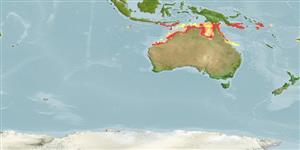Environment: milieu / climate zone / depth range / distribution range
экология
морской донно-пелагический, usually 8 - 10 m (Ref. 27621). Tropical; 9°S - 21°S
Western Pacific: northern Australia. Almost certainly present in southern Papua New Guinea.
Size / Вес / Возраст
Maturity: Lm ? range ? - ? cm
Max length : 32.0 cm TL самец/пол неопределен; (Ref. 3132); common length : 20.0 cm TL самец/пол неопределен; (Ref. 27621)
колючие лучи спинного плавника (общее число): 8; членистые (мягкие) лучи спинного плавника (общее число): 14; колючие лучи анального плавника 3; членистые (мягкие) лучи анального плавника: 12. Three dark vertical bands from nape, the first through eye, the second along the edge of the preopercle and the third down to the base of the pectoral fins; Dorsal fin with 8 spines increasing in length from a small anterior spine to a long posterior one; soft dorsal rays 14, much higher than spinous part and with the anterior ray produced into a short filament, the third ray prolonged into a long simple filament which extends past the caudal fin and the fourth and fifth rays also extended to beyond the hypural joint; anal fin with 3 slender spines and 12 soft rays, the second ray prolonged beyond the caudal fin and the third ray almost as long in small specimens.
Inhabit trawling grounds. Found more frequently in moderate depths on the continental shelf particularly close to submerged reefs or rough bottom (Ref. 27621). Feed mainly on crustaceans (Ref. 27621). Some cuttlefish are also taken (Ref. 27621).
Life cycle and mating behavior
половая зрелость | размножение | нерест | икра | Fecundity | личинки
McKay, R.J., 1997. FAO Species Catalogue. Vol. 17. Pearl perches of the world (family Glaucosomatidae). An annotated and illustrated catalogue of the pearl peches known to date. FAO Fish. Synop. 125(17):26p. Rome: FAO. (Ref. 27621)
Статус Красного Списка МСОП (Ref. 130435)
Угроза для людей
Harmless
Использование человеком
рыболовство: не имеет хозяйственного значения
дополнительная информация
народные названиясинонимыобмен веществхищникиэкотоксикологияразмножениеполовая зрелостьнерестSpawning aggregationFecundityикраРазвитие икры
ссылкиаквакультура (рыбоводство)особенности рыбоводствастепень растяжениягенетикаElectrophoresesнаследуемостьболезниобработкаNutrientsMass conversion
соавторыизображенияStamps, Coins Misc.звукиCiguateraскоростьтип плаванияжаберная областьOtolithsмозгзрение
инструменты
Специальные отчеты
Скачать в формате XML
ресурсы в Интернет
Estimates based on models
Preferred temperature (Ref.
123201): 26.7 - 28.8, mean 28 °C (based on 505 cells).
Phylogenetic diversity index (Ref.
82804): PD
50 = 0.6250 [Uniqueness, from 0.5 = low to 2.0 = high].
Bayesian length-weight: a=0.01995 (0.00906 - 0.04395), b=3.01 (2.83 - 3.19), in cm total length, based on all LWR estimates for this body shape (Ref.
93245).
Trophic level (Ref.
69278): 4.1 ±0.48 se; based on food items.
устойчивость к внешним воздействиям (Ref.
120179): средний (среднего размера), минимальное время удвоения популяции 1.4-4.4 года (Preliminary K or Fecundity.).
Fishing Vulnerability (Ref.
59153): Low vulnerability (22 of 100).
Nutrients (Ref.
124155): Calcium = 89.3 [49.7, 187.5] mg/100g; Iron = 0.754 [0.431, 1.340] mg/100g; Protein = 17.5 [16.4, 18.6] %; Omega3 = 0.207 [0.108, 0.387] g/100g; Selenium = 63.9 [31.1, 136.8] μg/100g; VitaminA = 27.9 [8.0, 98.2] μg/100g; Zinc = 0.988 [0.668, 1.518] mg/100g (wet weight);
